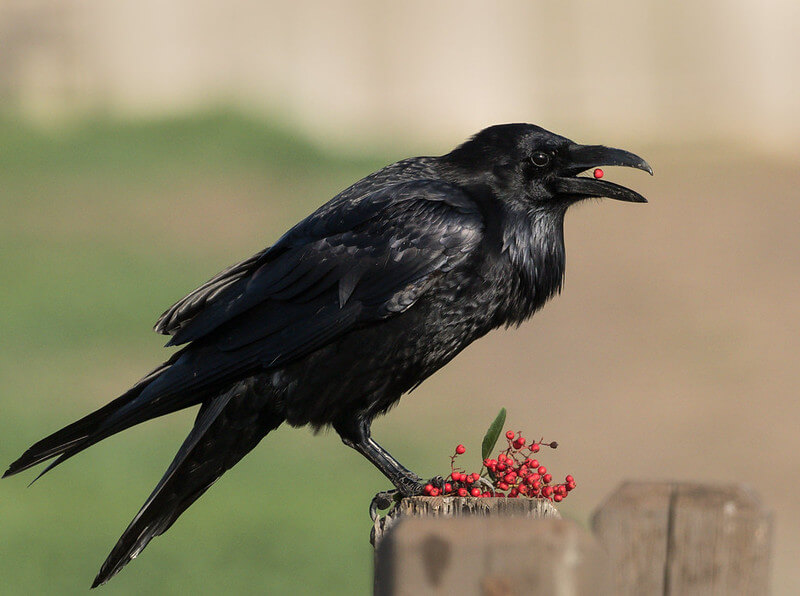The Raven’s Labor-Saving Device: A Squirrel
by Julie Brandauer
Broadcast 11.2009 and 3.17 & 3.20.2020

Photo by Ingrid Taylar, CC 2.0.
Listen:
Staring out a window while avoiding my to-do list for the day, a squirrel and a raven presented me with a peculiar sight. I observed the squirrel going from spot to spot, digging up seeds in the snow with a raven following close behind. As the squirrel worked its way through the snow, the raven would follow it and move in to inspect the squirrel’s findings. The raven had realized that a squirrel digging through the snow means food, and it was using the squirrel as its personal food finder.
This sight is not as unusual as I first thought. It turns out ravens use their intelligence to find and obtain food in four main ways, with slight variations: by using efficient foraging techniques, search imaging, using other animals and using tools.
To successfully find food, ravens use efficient foraging techniques. These techniques are based on a cost benefit-decision in which ravens only choose foods that yield a lot of energy for the least amount of work. In one study, ravens were observed eating whelks on the beaches of British Columbia. The ravens only chose the biggest whelks while ignoring smaller ones because they didn’t want to waste energy opening many small shells. Once the ravens had the whelks, they dropped them from an average of sixteen feet. If the ravens dropped the shells from a greater height, the shell shattered, leaving shards in the meat; if they dropped the shells from a lower height, the shell remained unbroken.
Along with efficient foraging techniques, ravens also use search images to find food efficiently. A search image is a visual cue that a raven associates with food. Again, researchers observed ravens sampling clams on a beach. The researchers placed meat under empty clam shells alongside whole clams. The quick-witted ravens that found the meat learned to use empty clam shells as a search image and continued to check the empty shells afterward. Those that had not found meat under empty shells continued to ignore them. Those ravens had learned to connect a search image with food and used it to search more efficiently.
Ravens also use search sounds to efficiently find food. Ravens that live in hunted areas apparently associate food with the sound of gunshots. When they hear gunshots, the birds head toward the sound because they have associated it with a hunter’s gut pile. The cunning ravens that make the correct association earn a hearty meal.
In addition to search images and sounds, ravens will use other animals to efficiently obtain food. Sometimes this means one raven will distract a cat by nipping its tail, while another raven will steal the cat’s kill. Other times, a raven, looking for leftovers, will follow an animal until that animal finds food – like the one I saw with a squirrel.
Lastly, ravens use tools in order to obtain food. Clever ravens have realized that dropping nuts, seeds, mussels and clams onto a hard surface cracks the hard shell and makes it easier to get to the meat inside. The shells are more likely to crack and less likely to roll away. Ravens have even concluded that a flat concrete or asphalt surface cracks hard shells better than a rocky shore.
The raven I saw outside my window with the squirrel was applying its ability to use other animals. It, like many other ravens, realized how it could benefit from just sitting back and watching another animal do all the work. The next time you see a raven, watch it. Is it following a squirrel, or dropping a nut from high in the air? Talk about animal intelligence.
Every week since 1991, Field Notes has inquired about Montana’s natural history. Field Notes are written by naturalists, students, and listeners about the puzzle-tree bark, eagle talons, woolly aphids, and giant puffballs of Western, Central and Southwestern Montana and aired weekly on Montana Public Radio.
Click here to read and listen to more Field Notes. Field Notes is available as a podcast! Subscribe on iTunes, Google Play, or wherever you listen to podcasts.
Interested in writing a Field Note? Contact Allison De Jong, Field Notes editor, at adejong [at] montananaturalist [dot] org or 406.327.0405.
Want to learn more about our programs as well as fun natural history facts and seasonal phenology? Sign up for our e-newsletter! You can also become a member and get discounts on our programs as well as free reciprocal admission to 300+ science centers in North America!












